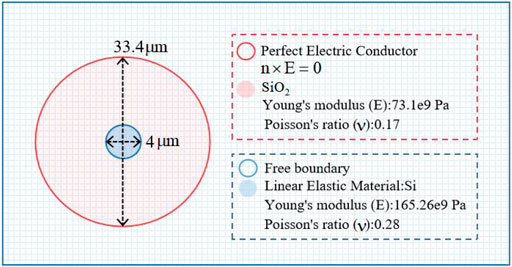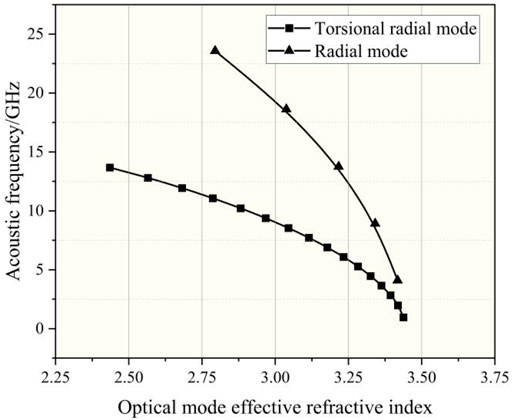- 1Key Laboratory of Advanced Transducers and Intelligent Control System of Ministry of Education, Taiyuan University of Technology, Taiyuan, Shanxi, China
- 2School of Instrument and Electronics, North University of China, Taiyuan, Shanxi, China
- 3College of Physics, Taiyuan University of Technology, Taiyuan, Shanxi, China
- 4Shanxi-Zheda Institute of Advanced Materials and Chemical Engineering, Taiyuan, Shanxi, China
As a new type of semiconductor fiber, silicon-core fibers have a higher non-linear effect compared with silica fibers. Forward-stimulated Brillouin scattering as a typical optical non-linear effect holds strong promise for applications in, for example, fiber-optic sensing. The study of the FSBS effect in silicon-core fibers facilitates further theoretical exploitation of the potential of FSBS in fiber-optic sensing. In this paper, the FSBS in the silicon-core fiber is studied using the finite element method. The model is based on a silicon-core fiber, whose silicon-core diameter is 4
1 Introduction
Silicon photonics, which emerged from the close combination of electrons and photons, is now the most active discipline in the field of integrated optics [1, 2]. The interaction of the optical field with electrons and phonons in silicon gives rise to a large number of non-linear effects and has a high third-order optical non-linearity [1, 3, 4]. Silicon-core fibers, which have been manufactured by Badding Group since 2008 [5], belong to a new type of semiconducting platform. The silicon-core fibers are robust, flexible, and cylindrically symmetric and are becoming a new platform for the development of non-linear optical devices [6]. The high refractive index contrast between the silicon core and the silica cladding can guarantee strong optical confinement for all signals near the near-infrared wavelength of 1,550 nm, resulting in strong optical guiding [1]. The high optical confinement generated by this large contrast (between Si and SiO2) makes it possible to observe strong non-linear optical interactions as observed in chip-scale devices [7].
Forward-stimulated Brillouin scattering, as an optical non-linearity, is a third-order non-linear process in which the optical and acoustic fields are coupled [8]. Excitation of strong forward-stimulated Brillouin scattering (FSBS) in silicon has been realized in a new class of nanoscale opto-mechanical waveguides with record-high non-linearity (four times larger than that in silica fibers) [9]. Compared to nanoscale linear silica waveguides, both with micron-sized core diameters and silica cladding, these large-core fibers provide better power-handling capabilities [10]. However, its high core-cladding index contrast means that it does not support the weak waveguide approximation, and it will guide multiple vector modes [11]. The properties of FSBS in silica-core fibers in the presence of multiple vector modes have then not been studied in detail [12]. In this study, we model the forward Brillouin scattering in a multimode silicon-core fiber using the finite element method. The model is based on a silicon-core fiber with a core diameter of 4
2 Simulation and discussion
2.1 Simulation of optical wavefield modes in silicon-core fibers
In this study, we take silicon-core fiber as the prototype, where the core diameter is 4
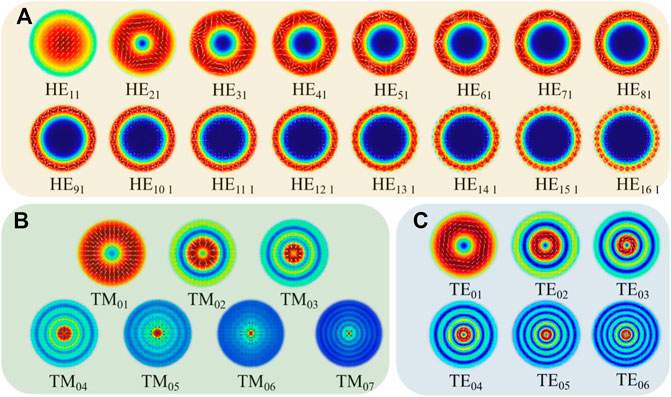
FIGURE 2. (A) Field intensity distribution of the HE mode in silicon-core fiber. (B) Field intensity distribution of the TM mode in silicon-core fiber. (C) Field intensity distribution of the TE mode in silicon-core fiber.
2.2 Phase matching of optical and acoustic fields
For FSBS, the optical and acoustic fields confined in the fiber can be coupled by inelastic light scattering, and electrostriction in the fiber causes a change in the dielectric constant, which affects the refractive index and forms a time-dependent refractive index grating [22]. In the process of interaction, both energy and momentum must be conserved, so the pump light, scattered light, and acoustic field must satisfy the phase-matching condition and the momentum conservation condition [23], specifically in the FSBS studied in this paper; the wave vectors of the pump light, scattered light, and acoustic field should follow [24]:
For multimode fibers, the pump light has multiple conduction modes, each with its own different effective refractive index
As shown in Figure 3, the acoustic field mode at this point is at a position very close to the cutoff in the dispersion relation, but the wave vector of the acoustic mode is not exactly equal to 0. The wave vector of the acoustic mode can be estimated by [27, 28]:

FIGURE 3. Phase-matching relationship of the pump light, scattered light, and acoustic field in silicon-core fiber.
where
2.3 Excitation of guided acoustic modes in silicon-core fibers with multiple modes
The frequencies of the excitable elastic modes in FSBS are fixed by the structure and are independent of the incident light frequency. The acousto-optic matching condition for forward Brillouin scattering requires the acoustic field modes to be located at the approximate cutoff in the dispersion curve, when the phase velocity of these acoustic waves tends toward infinity and the group velocity tends toward zero, so the acoustic field modes in FSBS are called guided acoustic modes [30].The core of a silicon-core fiber is a linear elastic material, and the fluctuation equation of linear elastodynamics is established, and this equation describes various elastic waves in a uniform rod with a circular cross-section [31]:
The f on the right-hand side of the equation is the density of the volume force that causes small-amplitude acoustic vibrations in the medium. For FSBS,
In Eqs. 5.1, 5.2,
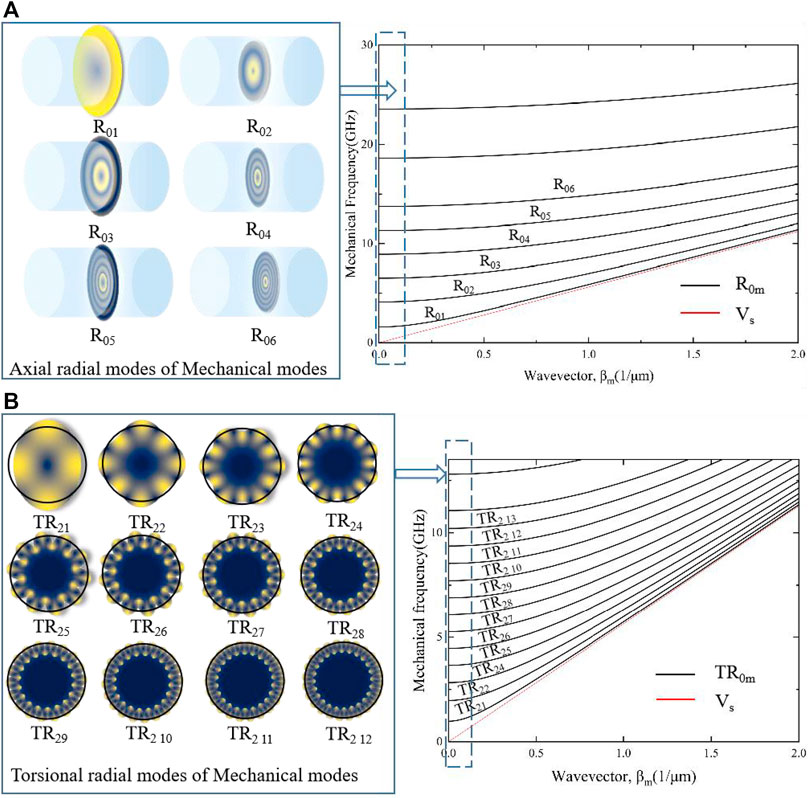
FIGURE 4. (A) Acoustic field modes
The acoustic field modes excited by forward Brillouin scattering in the silicon-core fiber are the radial mode (
3 Gain of FSBS of the silicon-core fiber and the effects of
After the pump and scattered optical modes at a given
where
The forward Brillouin gain of the silicon-core fiber can be obtained by bringing each physical parameter of silicon and silica in Table 1 into Eq. 7. Figure 5 shows the forward Brillouin gain of the acoustic field coupled with R0m for the pump light-scattered light mode pairs TM01–TM01, TM02–TM02, TM03–TM03, TM04–TM04, and TM05–TM05, respectively. Figure 5A shows the FSBS gain when the sound field is coupled with R01, Figure 5B shows the FSBS gain when the sound field is coupled with
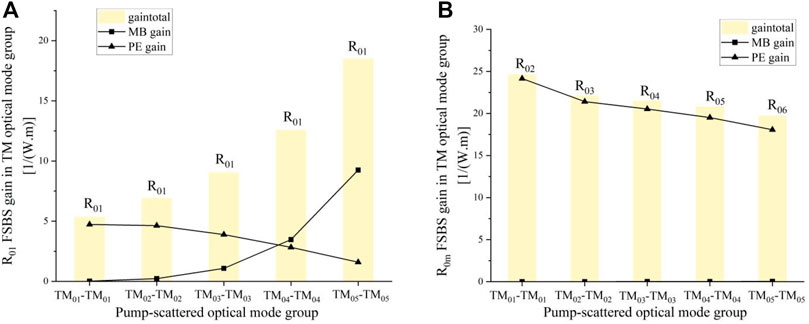
FIGURE 5. (A) Forward Brillouin gain of the acoustic field coupled with R01 for the pump light-scattered light mode pair of transverse magnetic modes TM0m–TM0m. (B) Forward Brillouin gain of the acoustic field coupled to R0m for the pump light-scattered light mode pair of transverse magnetic modes TM0m–TM0m.
In Figure 5A, the total gain increases with the higher order of the optical field mode pair and the contribution of the photoelastic perturbation to the total gain decreases, while the contribution of the moving boundary effect to the total gain increases all the time and exceeds the photoelastic perturbation at TM04–TM04 and reaches the maximum at TM05–TM05 in the case of both acoustic fields as R01. As mentioned in Ref. 37, the FSBS gain is more dominated by the moving boundary effect as the size decreases, and the moving boundary effect decays sharply as the size increases. In the process of pumping light-scattering optical mode pairs from low to high order in silicon-core fibers, there is a gradual concentration of optical field energy in the core, and for coupling the same acoustic modes, the FSBS gain is also gradually dominated by the moving boundary effect, i.e., the higher-order optical modes of large-size silicon-core fibers have an effect similar to those of small-size fibers in the process of FSBS gain excitation.
In Figure 5B, R02, R03, R04, R05, and R06 are all acoustic fields corresponding to the maximum value in the FSBS gain spectrum for each R0m optical mode pair, with maximum gains of 24.65(1/mw), 22.14(1/mw), 21.54(1/mw), 20.8(1/mw), and 19.73(1/mw), respectively, and contributed almost exclusively by photoelastic perturbations. Figure 5B illustrates that the in-mode forward Brillouin scattering of TM optical modes can only obtain increased gain when coupling the axial radial mode R0m and that the normal electrostriction force is the largest force driving the realization of this process. Figure 6 shows the complete FSBS gain spectra for the pump light-scattered light mode pairs TM01–TM01, TM02–TM02, TM03–TM03, TM04–TM04, and TM05–TM05, respectively. The line width of Brillouin scattering within the silicon-core fiber mode also gradually increases during the change in pump light and scattered light modes from lower to higher orders, and the spectral line width of Brillouin scattering gradually increases with the increase in the mode order. The main reason is that the smaller propagation constants of the higher-order modes in the multimode fiber make their effective refractive indices lower, as described in the paper [39].
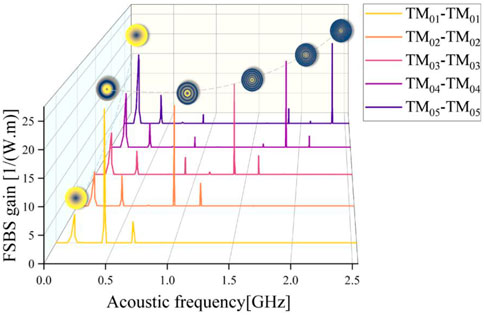
FIGURE 6. Complete FSBS gain spectrum for pump light-scattered light mode pairs for the transverse magnetic mode TM0m–TM0m, respectively.
The aforementioned results illustrate that each mode in the multimode silicon-core fiber independently excites its own Brillouin scattering spectrum, where the acoustic field mode R0m always corresponds to the highest one in the gain spectrum of each optical mode pair, and its frequency shift varies greatly with the increasing order of the mode pair. The change in the mode pair can be equated to the change in the effective refractive index neff in the fiber, from which it can be concluded that the acoustic field mode R0m has a non-linear change for the change in the effective refractive index of the core of the silicon-core fiber.
When the pump-scattered light mode pairs are mixed mode HE11-HE11, HE21-HE21, HE31-HE31, HE41-HE41, HE51-HE51, HE61-HE61, HE71-HE71, HE81-HE81, HE91-HE91, HE10 1-HE10 1, HE11 1-HE11 1 HE12 1-HE12 1, HE13 1-HE13 1, HE14 1-HE14 1, HE15 1-HE15 1, HE16 1-HE16 1 when the sound field is coupled to R01 and TR2m with the forward Brillouin gain shown in Figure 7A shows the FSBS gain when the sound field is coupled to R01, and Figure 7B shows the FSBS gain when the sound field is coupled to TR2m. The yellow gain bars in Figure 7B represent, from left to right, TR21, TR22, TR23, TR24, TR25, TR26, TR27, TR28, TR29, TR2 10, TR2 11, TR2 12, TR2 13, TR2 14, and the gain of TR2 15 and TR2 16. In Figure 7A, the total gain decreases and then increases with the higher order of the optical field mode pair, and the contribution of the photoelastic effect to the total gain gradually decreases, while the contribution of the moving boundary perturbation to the total gain gradually increases, and the moving boundary perturbation and the photoelastic effect are equivalent at HE11 1–HE11 1, after which the moving boundary perturbation gradually exceeds the photoelastic effect and reaches the maximum at HE16 1–HE16 1. Unlike the transverse magnetic TM0m mode pair, the total gain of the hybrid mode HEn1–HEn1 undergoes a process of decreasing and then increasing, with the FSBS gain of the lowest order HE11–HE11 controlled by the photoelastic effect and the FSBS gain of the highest order HE16 1–HE16 1 controlled by the moving boundary perturbation.
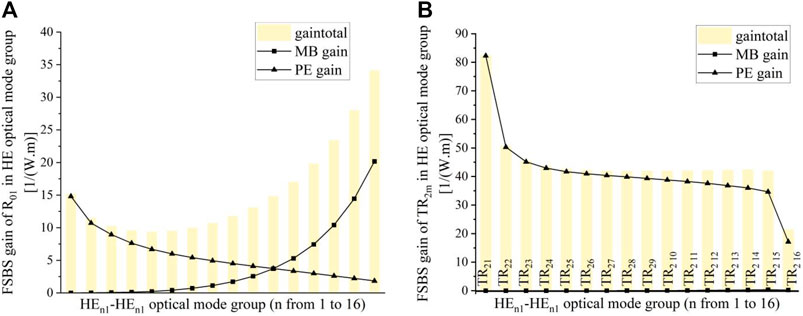
FIGURE 7. (A) Forward Brillouin gain of the acoustic field coupled to R01 for pump light-scattered light mode pairs with mixed mode HEn1–HEn1, respectively. (B) Forward Brillouin gain of the acoustic field coupled to TR2m for pump light-scattered light mode pairs with mixed mode HEn1–HEn1, respectively.
In Figure 7B, each order mode of R0m is the acoustic field corresponding to the maximum value in the FSBS gain spectrum of each HEn1–HEn1 optical mode pair, with maximum gains of 82.49 (1/mw), and contributed almost exclusively by photoelastic perturbations. Figure 7B illustrates that unlike the TM optical mode, the in-mode forward Brillouin scattering of the HE optical mode can only obtain increased gain when coupling the tangential radial mode TR2m, and the tangential electrostriction force is the largest force driving this process to be achieved.
Figure 5B and Figure 7B show that the electrostriction force is the largest driving force to achieve the maximum FSBS gain, both when coupling to R0m and TR2m. The moving boundary effect, however, is only better when coupling R01 and is better when coupling R01 in higher-order optical modes.
Figure 8 shows the complete FSBS gain spectrum for the pump light-scattered light mode pair of HEn1–HEn1 (n from 1 to 16), respectively. The line width of Brillouin scattering within the silicon-core fiber mode also gradually increases as the pump light and scattered light modes change from lower to higher orders, i.e., the spectral line width of Brillouin scattering gradually increases with the increase in the mode order.
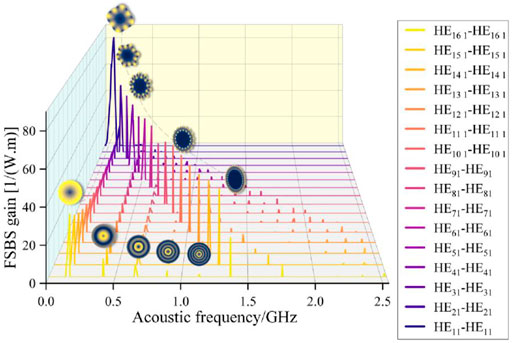
FIGURE 8. Complete FSBS gain spectrum for the pump light-scattered light mode pair with the mixed mode HEn1–HEn1, respectively.
The aforementioned results indicate that HEn1–HEn1 couples more torsional radial mode TR2m, the frequency shift of the torsional radial mode also shifts to high frequencies as the mode pair changes, and its frequency shift varies greatly with the increase in the mode pair order. After the change in the mode pair is equated to the change in the effective refractive index neff in the fiber, it can be concluded that the acoustic field mode TR2m has a non-linear change for the change in the effective refractive index of the core of the silicon-core fiber.
The horizontal coordinate of Figure 9 shows the effective refractive index change for the pumped light-scattered light mode pair, and the vertical coordinate shows the frequency shift of the sound field mode. The frequency shift of the acoustic field radial mode is larger than that of the torsional radial mode for the same effective refractive index change, implying that the radial mode R0m is more sensitive to the effective refractive index change than the torsional radial mode TR2m for the acoustic field frequency shift.
Figure 10 shows the FSBS gain when the acoustic field is coupled to R01. In Figure 10, the total gain gradually increases with the higher order of the optical field mode pair, and the contribution of both the photoelastic effect and the moving boundary perturbation to the total gain gradually increases, and the moving boundary perturbation and the photoelastic effect are equivalent at TE07–TE07, after which the moving boundary perturbation increases more rapidly and reaches the maximum at TE08–TE08, but at this time, the photoelastic effect does not decrease to nearly 0. The moving boundary perturbation and photoelastic effect still work together.
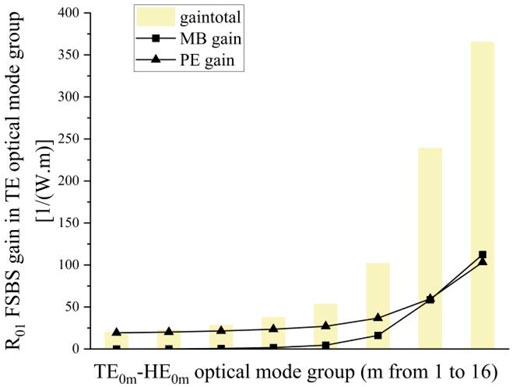
FIGURE 10. Forward Brillouin gain of the acoustic field coupled with R01 when the pump light-scattered light mode pair is the mixed mode TE0m–TE0m, respectively.
Figure 11 shows the complete FSBS gain spectrum for the pump light-scattered light mode pair TE0m–TE0m (m from 1 to 8), respectively. Unlike the FSBS gain spectra of TM0m–TM0m and HE1m–HE1m, TE0m–TE0m has only one high peak, and its gain spectrum is not in the form of a double peak. This means that the TE0m–TE0m optical mode pair is only coupled to the fundamental mode R01 of the axial radial mode, which is related to the fact that the electric field direction of the TE optical mode is only along the tangential direction of the fiber cross-section (without any axial direction).
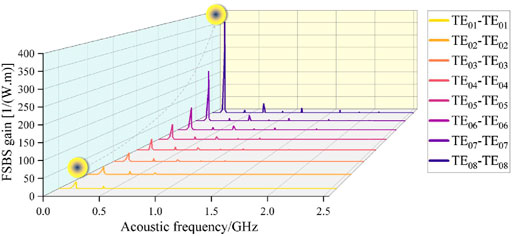
FIGURE 11. Complete FSBS gain spectrum for pump light-scattered light mode pairs for the mixed mode TE0m–TE0m, respectively.
The TE0m–TE0m optical mode pair and AR01 coupling produced a maximum gain value of 365.57 (1/mw) for forward Brillouin scattering from a silicon-core fiber, resulting from TE08–TE08 coupling with R01. Figure 12 shows the FSBS gain spectra of pumped and scattered light from different orders, that is, the gain spectra when scattered to higher orders, whose maximum value is also smaller than the FSBS gain of pumped and scattered light from the same order. It can be seen that the maximum FSBS gain in the silicon-core fiber should come from the intra-modal FSBS. Since the Brillouin gain is a combination of photoelastic perturbation and moving boundary effect, where the moving boundary effect decreases with the increase in the fiber volume, the forward Brillouin gain in the silicon waveguide decreases with the increase in the volume of the silicon waveguide [37, 40]. While a silicon fiber with a diameter of 4
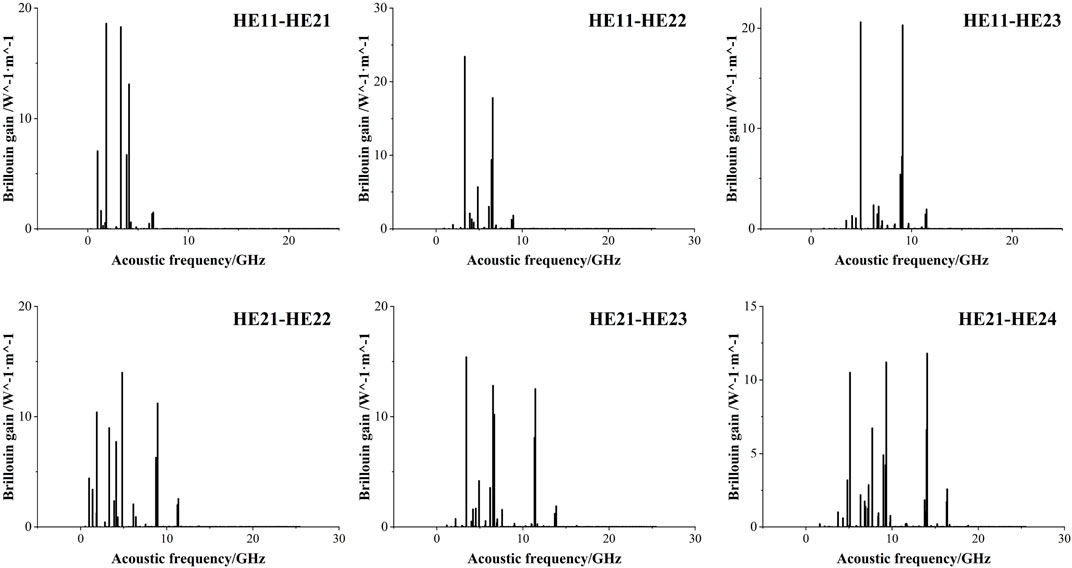
FIGURE 12. Forward Brillouin gain spectrum from lower-order light field scattering to the higher-order light field.
4 Conclusion
By studying the FSBS in the silicon-core fiber, it is shown that the sound field mode R0m has the best coupling with the TM and TE optical mode, and the sound field mode TR2m has the best coupling with the HE optical mode. In the case of the best coupling, the moving boundary perturbations and photoelastic effects each contribute. The contribution of the photoelastic effect is higher when R0m and TM0m are coupled, and the contribution of the photoelastic effect is also greater, when R0m and HE1m are coupled. Between R0m and TE0m, moving boundary perturbations and photoelastic effects contribute similarly. In the case of the same effective refractive index change, the frequency shift of the radial mode of the sound field is compared with that of the torsional radial mode. It is concluded that the radial mode R0m is more sensitive to the change in the effective refractive index than the torsional radial mode TR2m. This means that building on previous studies by Y Antman et al. [41] and Yanping Xu et al [42] for the study of FSBS-based opto-mechanical simultaneous sensors, this study offers a new possibility to design simultaneous sensors by exploiting the difference in sensitivity to neff between radial and torsional radial modes. Finally, it is confirmed that the silicon-core fiber can obtain a strong FSBS gain of 365.57 (1/mw) without reducing to the usual size of the silicon waveguide. In this case, the FSBS are coupled at R01 and TE08. This work opens up new possibilities in the field of CMOS and MEMS by mixing Brillouin device physics with silicon photonics. It paves the way for further research in the fields of frequency-tunable laser emission, mode-locked pulsed lasers, low-noise oscillators, and optical gyroscopes.
Data availability statement
The raw data supporting the conclusion of this article will be made available by the authors, without undue reservation.
Author contributions
YY: writing—original draft preparation, data curation, software, and validation. TW: writing—reviewing and editing and investigation. YL: investigation and reviewing. BW: reviewing and editing. MZ: reviewing and editing.
Funding
This work was supported by the National Natural Science Foundation of China (62075151, 62075153, 61527819, and 61875146), the Patent Promotion and Exploitation Program of Shanxi Province (20200734), the Transformation of Scientific and Technological Achievements Programs of Higher Education Institutions in Shanxi, Fund for Shanxi “1331 Project” Key Innovative Research Team, and Shanxi-Zheda Institute of Advanced Materials and Chemical Engineering.
Conflict of interest
The authors declare that the research was conducted in the absence of any commercial or financial relationships that could be construed as a potential conflict of interest.
Publisher’s note
All claims expressed in this article are solely those of the authors and do not necessarily represent those of their affiliated organizations, or those of the publisher, the editors, and the reviewers. Any product that may be evaluated in this article, or claim that may be made by its manufacturer, is not guaranteed or endorsed by the publisher.
References
1. Jalali B, Fathpour S. Silicon photonics. J lightwave Technol (2006) 24(12):4600–15. doi:10.1109/JLT.2006.885782
2. Hou C, Jia X, Wei L, Tan SC, Zhao X, Joannopoulos JD, et al. Crystalline silicon core fibres from aluminium core preforms. Nat Commun (2015) 6(1):6248–6. doi:10.1038/ncomms7248
3. Leuthold J, Koos C, Freude W. Nonlinear silicon photonics. Nat Photon (2010) 4(8):535–44. doi:10.1038/nphoton.2010.185
4. Gupta N, McMillen C, Singh R, Podila R, Rao AM, Hawkins T, et al. Annealing of silicon optical fibers. J Appl Phys (2011) 110(9):093107. doi:10.1063/1.3660270
5. Healy N, Sparks JR, Petrovich MN, Sazio PJA, Badding JV, Peacock AC. Large mode area silicon microstructured fiber with robust dual mode guidance. Opt Express (2009) 17(20):18076–82. doi:10.1364/OE.17.018076
6. Mehta P, Healy N, Baril NF, Sazio PJA, Badding JV, Peacock AC. Nonlinear transmission properties of hydrogenated amorphous silicon core optical fibers. Opt express (2010) 18(16):16826–31. doi:10.1364/OE.18.016826
7. Ikeda K, Shen Y, Fainman Y. Enhanced optical nonlinearity in amorphous silicon and its application to waveguide devices. Opt express (2007) 15(26):17761–71. doi:10.1364/OE.15.017761
8. Van Laer R, Kuyken B, Van Thourhout D, Baets R. Observation of 4.4 dB Brillouin gain in a silicon photonic wire[C]. In: 2014 IEEE Photonics Conference; 12-16 October 2014; San Diego, CA, USA (2014). p. 558–9. doi:10.1109/IPCon.2014.6995498
9. Kittlaus EA, Otterstrom NT, Rakich PT. On-chip inter-modal Brillouin scattering. Nat Commun (2017) 8(1):15819–9. doi:10.1038/ncomms15819
10. Peacock AC, Mehta P, Horak P, Healy N. Nonlinear pulse dynamics in multimode silicon core optical fibers. Opt Lett (2012) 37(16):3351–3. doi:10.1364/OL.37.003351
11. Schulze C, Brüning R, Schröter S, Duparre M. Mode coupling in few-mode fibers induced by mechanical stress. J Lightwave Tech (2015) 33(21):4488–96. doi:10.1109/JLT.2015.2475603
12. Wang N, Alvarado-Zacarias JC, Habib MS, Wen H, Antonio-Lopez JE, Sillard P, et al. Mode-selective few-mode Brillouin fiber lasers based on intramodal and intermodal SBS. Opt Lett (2020) 45(8):2323–6. doi:10.1364/OL.385444
13. Hounsome LS, Jones R, Shaw MJ, Briddon PR. Photoelastic constants in diamond and silicon. physica status solidi (2006) 203(12):3088–93. doi:10.1002/pssa.200671121
14. Biegelsen DK. Photoelastic tensor of silicon and the volume dependence of the average gap. Phys Rev Lett (1974) 32(21):1196–9. doi:10.1103/PhysRevLett.32.1196
15. Mashanovich GZ, Milosevic M, Matavulj P, Stankovic S, Timotijevic B, Yang PY, et al. Silicon photonic waveguides for different wavelength regions. Semiconductor Sci Technol (2008) 23(6):064002. doi:10.1088/0268-1242/23/6/064002
16. Levine ZH, Zhong H, Wei S, Allan DC, Wilkins JW. Strained silicon: A dielectric-response calculation. Phys Rev B (1992) 45(8):4131–40. doi:10.1103/PhysRevB.45.4131
17. Huang L, Leng J, Zhou P, Guo S, Lu H, Cheng X. Adaptive mode control of a few-mode fiber by real-time mode decomposition. Opt express (2015) 23(21):28082–90. doi:10.1364/OE.23.028082
18. Hong S, Choi K, Lee YS, Oh K, et al. Two-mode fiber with a reduced mode overlap for uncoupled mode-division multiplexing in C+ L band. Curr Opt Photon (2018) 2(3):233–40. doi:10.3807/COPP.2018.2.3.233
19. Snitzer E, Osterberg H. Observed dielectric waveguide modes in the visible spectrum. JOSA (1961) 51(5):499–505. doi:10.1364/JOSA.51.000499
20. Kawano K, Kitoh T. Introduction to optical waveguide analysis: Solving maxwell's equation and the schrödinger equation. United States: John Wiley and Sons (2004).
21. Mahlein HF, Oberbacher R, Rauscher W. An integrated optical TE-TM mode splitter. Appl Phys (1975) 7:15–20. doi:10.1007/BF00900514
22. Wagner D, Thumm M, Kasparek W, Muller GA, Braz O. Prediction of TE-TM-and hybridmode transmission losses in gaps of oversized waveguides using a scattering matrix code. Int J infrared millimeter waves (1996) 17(6):1071–81. doi:10.1007/BF02101439
23. Bao X, Chen L. Recent progress in Brillouin scattering based fiber sensors. Sensors (2011) 11(4):4152–87. doi:10.3390/s110404152
24. Kobyakov A, Sauer M, Chowdhury D. Stimulated Brillouin scattering in optical fibers. Adv Opt Photon (2010) 2(1):1–59. doi:10.1364/AOP.2.000001
25. Carmon T, Rokhsari H, Yang L, Kippenberg TJ, Vahala KJ. Temporal behavior of radiation-pressure-induced vibrations of an optical microcavity phonon mode. Phys Rev Lett (2005) 94(22):223902. doi:10.1103/PhysRevLett.94.223902
26. Lin Q, Rosenberg J, Jiang X, Vahala KJ, Painter O. Mechanical oscillation and cooling actuated by the optical gradient force. Phys Rev Lett (2009) 103(10):103601. doi:10.1103/PhysRevLett.103.103601
27. Dainese P, Russell PSJ, Wiederhecker GS, Joly N, Fragnito HL, Laude V, et al. Raman-like light scattering from acoustic phonons in photonic crystal fiber. Opt express (2006) 14(9):4141–50. doi:10.1364/OE.14.004141
28. Aspelmeyer M, Kippenberg TJ, Marquardt F. Cavity optomechanics. Rev Mod Phys (2014) 86(4):1391–452. doi:10.1103/RevModPhys.86.1391
29. Wiederhecker GS, Dainese P, Mayer Alegre TP. Brillouin optomechanics in nanophotonic structures. APL Photon (2019) 4(7):071101. doi:10.1063/1.5088169
30. Shelby RM, Levenson MD, Bayer PW. Guided acoustic-wave Brillouin scattering. Phys Rev B (1985) 31(8):5244–52. doi:10.1103/PhysRevB.31.5244
31. Biryukov AS, Sukharev ME, Dianov EM. Excitation of sound waves upon propagation of laser pulses in optical fibres. Quan Elect (2002) 32(9):765–75. doi:10.1070/QE2002v032n09ABEH002289
33. Thurston RN. Elastic waves in rods and clad rods. The J Acoust Soc America (1978) 64(1):1–37. doi:10.1121/1.381962
34. Wolff C, Van Laer R, Steel MJ, Eggleton BJ, Poulton CG. Brillouin resonance broadening due to structural variations in nanoscale waveguides. New J Phys (2016) 18(2):025006. doi:10.1088/1367-2630/18/2/025006
35. Wang Y, Li K, Yu Y, Wang W, Li S, Li Y, et al. Tailorable stimulated Brillouin scattering laser based on silicon ring waveguides. Front Phys (2021) 9:539. doi:10.3389/fphy.2021.749880
36. Sturmberg BCP, Dossou KB, Smith MJA, Morrison B, Poulton CG, Steel MJ, et al. NumBAT: The integrated, open source numerical Brillouin analysis tool (2018). arXiv preprint arXiv:1811.10219, doi:10.48550/arXiv.1811.10219
37. Qiu W, Rakich PT, Shin H, Dong H, Soljacic M, Wang Z. Stimulated Brillouin scattering in nanoscale silicon step-index waveguides: A general framework of selection rules and calculating SBS gain. Opt express (2013) 21(25):31402–19. doi:10.1364/OE.21.031402
38. Schmidt MK, O’Brien MC, Steel MJ, Poulton CG. Arraw: Anti-resonant reflecting acoustic waveguides. New J Phys (2020) 22(5):053011. doi:10.1088/1367-2630/ab7d79
39. Hansen TP, Broeng J, Libori SEB, Knudsen E, Bjarklev A, Jensen J, et al. Highly birefringent index-guiding photonic crystal fibers. IEEE Photon Tech Lett (2001) 13(6):588–90. doi:10.1109/68.924030
40. Van Laer R, Kuyken B, Van Thourhout D, Baets R. Analysis of enhanced stimulated Brillouin scattering in silicon slot waveguides. Opt Lett (2014) 39(5):1242–5. doi:10.1364/OL.39.001242
41. Antman Y, Clain A, London Y, Zadok A. Optomechanical sensing of liquids outside standard fibers using forward stimulated Brillouin scattering. Optica (2016) 3(5):510–6. doi:10.1364/OPTICA.3.000510
Keywords: silicon photonics, forward-stimulated Brillouin scattering, non-linear optics, multimode fiber, photoelastic effect, moving boundary perturbations
Citation: Yao Y, Wang T, Liu Y, Wang B and Zhang M (2023) Forward-stimulated Brillouin scattering in silicon-core fibers. Front. Phys. 11:1158881. doi: 10.3389/fphy.2023.1158881
Received: 04 February 2023; Accepted: 27 February 2023;
Published: 16 March 2023.
Edited by:
Hao Jiang, Huazhong University of Science and Technology, ChinaReviewed by:
Irina Kabakova, University of Technology Sydney, AustraliaJingjing Zheng, Beijing Jiaotong University, China
Copyright © 2023 Yao, Wang, Liu, Wang and Zhang. This is an open-access article distributed under the terms of the Creative Commons Attribution License (CC BY). The use, distribution or reproduction in other forums is permitted, provided the original author(s) and the copyright owner(s) are credited and that the original publication in this journal is cited, in accordance with accepted academic practice. No use, distribution or reproduction is permitted which does not comply with these terms.
*Correspondence: Tao Wang, d2FuZ3Rhb0B0eXV0LmVkdS5jbg==; Yi Liu, bGl1eWlfYnNAbnVjLmVkdS5jbg==
 Yao Yao1
Yao Yao1 Tao Wang
Tao Wang Yi Liu
Yi Liu